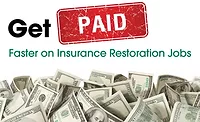How to Get Paid When Lenders Are Loss Payees
Over the years, I have had the same question asked numerous times: How do we get paid when both the lender and the property owner are loss payees on the check from the insurance company?
It is common practice for a lender in their loan documents to require a property owner to maintain insurance coverage on the building the lender is making a loan on. Lenders do this to avoid a situation where a peril of some sort (i.e., fire, lighting windstorm, hail, etc.) makes the building worth less than the outstanding amount of the loan. Lenders do everything they can do to avoid having no collateral value to back a loan on a property. Lenders force borrowers to purchase property insurance to protect the collateral backing the loan. If a borrower does not provide annual evidence that the building is insured, the lender will purchase the insurance coverage and bill the borrower for the premium.
To make sure that any insurance proceeds after a covered loss go towards either paying off a loan in the event of a total loss or are spent repairing the structure to its pre-loss condition, it is common practice for lenders to be named as loss payees in the property insurance policy purchased by the borrower. To become a loss payee, the insurance policy is endorsed with the specific information of the lender. That is how claims checks end up being issued with two loss payees - the insurance company had a record of who the lender is.
With a lender as loss payee, the property owner and the lender both need to sign the claim check before it can be cashed.
Lenders have an interest in seeing that damaged properties used as collateral to secure their loans are restored. So one wouldn’t think refusing to pay or release insurance proceeds to restoration contractors would be in the best interests of lenders. But it is not unheard of.
Since there is no way to avoid the bank’s involvement in being named as a loss payee and two party checks, what options are there to facilitate getting paid on a timely basis for the work performed?
Because lenders as loss payees are driven by requirements in contracts (loans documents and insurance policies), I thought it would be good to get a lawyer’s perspective on the topic. To get that perspective I went to Tom Cardone, an attorney who practices in the restoration business sector, for his suggestions on how to ensure that insurance proceeds end up in the hands of the contractor that has performed the restoration work and are not retained by lenders or paid to property owners, who may allocate the proceeds to other debts, leaving the restoration contractor in a difficult situation. Mr. Cardone is with the firm Brennan, Manna & Diamond, LLC, which has offices in Ohio and Florida. He is licensed in Ohio and Georgia.
Here are Mr. Cardone’s thoughts on the subject:
-
Communication is key. Cooperate with lenders and inform them of the status of projects. Lenders will probably not speak with the restoration contractor unless the property owner signs an authorization or limited power of attorney, so it is important to obtain appropriate documentation from the customer at the beginning of the project. Notify the lender that you have been hired by the property owner. Invite the lender to contact you if any questions arise regarding the status or completion of the project. Determine what inspections and documentation will be required from the mortgage company. Notify them in a timely manner when milestones requiring payment from the owner have been reached. Keep records of all communications with the mortgage company and document everything. Provide any information or documentation required by the lender in a timely manner, and send it in a format allowing receipt of the documentation to be tracked (i.e. certified mail).
-
Try to obtain a joint-payment authorization from the property owner/policy holder. Some insurance companies or adjusters may be willing to name the restoration contractor as an additional loss payee on all checks issued for work performed by the contractor. But this requires authorization from the policy holder, and possibly the lender, if the lender is already a loss payee. If the contractor is named as a joint payee on the check, the contractor has at least some control over the insurance proceeds. (The property owner could not spend the insurance proceeds on something else, for example.)
-
A better way to control insurance proceeds is to obtain an assignment of insurance benefits from the policy holder/property owner, if permitted in the contractor’s state. An assignment of benefits is different from a joint-payment authorization. A joint-payment authorization is essentially a request that the contractor be named a co-payee on any check issued by the insurance company. An assignment is a legal transfer of the right to collect insurance proceeds, whereby the contractor steps into the shoes of the policy holder. Restoration contractors who receive assignments of benefits, however, may have competing claims with lenders.
-
If the contractor’s state allows the restoration professional to file a mechanic’s lien, the contractor should be sure to follow the correct procedure and to comply with deadlines. Filing a lien may motivate the customer to assist with obtaining insurance proceeds from the lender, if they are not already helping.
-
If the contractor is not being paid, stop work. Be sure to follow any necessary contractual requirements. Of course, restoration contractors want to provide superior customer service. Filing a lien or stopping work may not make the customer happy, but restoration contractors have to act in their best interests. If you are owed a significant amount of money, it appears that the only realistic source of payment is from insurance proceeds, and if you cannot obtain those proceeds, stopping work may speed a resolution. Again, it is in the best interest of lenders to have the property fully restored.
-
If lenders refuse to relinquish control of insurance proceeds, you may want to consult legal counsel regarding the likelihood of success in a lawsuit against the lender. Mortgage documents generally contain an assignment of insurance benefits in favor of the lender, so the lender may have a superior claim to proceeds. Depending upon the state, however, various remedies may be available to the contractor.
-
If all else fails, it is important to remember who the restoration professional’s contract is with and what alternative sources of payment are available. The lender and insurance company are potential collection targets. While there is an expectation that insurance proceeds will be used to pay the restoration contractor, in the end, the owner is still liable for nonpayment for work performed.
On what to do if the lender is dragging their feet to sign money over for work performed:
Communication is key. Stay on top of the lender and communicate with them regularly. Be mindful of deadlines for filing liens and do not let a project get out of control financially before you start taking the next steps in getting paid. Communicate with the customer as well. Get them on the contractor’s side and explain the situation. While litigation and attorney involvement should not be the first course of action, early involvement of an attorney may be beneficial.
On whether the lender can keep your money:
Possibly, yes. Lenders have an interest in seeing the property is restored, so you wouldn’t think they would refuse to apply insurance proceeds to the restoration of the property. However, mortgage documents generally contain assignments of insurance proceeds and allow lenders to apply proceeds to unpaid amounts owed, in many cases even if the loan is not in default. A contractor may potentially have a claim - for example, unjust enrichment - against a lender who refuses to sign over insurance proceeds. Before pursuing action directly against a lender, however, you should be sure to consult with experienced legal counsel to consider their legal rights and the rights of the lender, as well as the cost of any action vs. the likelihood of success.
On if the mortgage is in arrears:
See above. Lenders are more likely to retain insurance proceeds if the property owner is in arrears in their mortgage payments. Remember, property owners are still responsible to pay the contractor for the work performed.
On slow pay vs. non pay:
Any time you are having difficulty getting paid, you should consider whether the situation is one of either “slow pay” or “no pay.” As stated above, keeping in constant contact with the appropriate parties and pressing the issue is key to getting paid. Contractors should not start the process with an adversarial or litigious tone. Use the least adversarial tools first. But if it comes down to it, do not be afraid to aggressively assert your rights.
On filing a lien:
Mechanics’ and materialmen’s liens can be useful tools for any contractor attempting to get paid. Generally, unpaid contractors can file liens on property for which they have provided supplies or have performed work or services. Contractors can foreclose on their liens, and the property on which the lien is filed is sold, typically in a sheriff’s sale or judicially supervised auction. The proceeds of the sale are used to pay the contractor. It is important to strictly follow the particular state’s lien procedure to ensure liens are enforceable. It is also important not to delay when filing a lien. Not only may a contractor miss an important deadline, but it may also lose priority to other secured parties or claimants who may have other claims or who themselves file liens.
The mere filing of a lien is often sufficient incentive to motivate a property owner to pay, or to get them to convince their lender to release insurance proceeds intended to be used to restore the premises. But it is also important to keep in mind that in most states mortgages or other first-in-time encumbrances filed on the property have a higher priority over construction liens. Therefore, a buyer at a lien-foreclosure sale would purchase the property “subject to” the higher priority mortgage, etc. While it may be relatively inexpensive to file a lien, it is important to consider the cost vs. the realistic benefit of foreclosing a mechanic’s lien.
On when and where to seek help:
Restoration and remediation professionals having difficulty getting paid should consult with legal counsel licensed in their particular states who are experienced in property insurance claims and restoration fields. An experienced attorney will be able to outline the various options for contractors and propose an appropriate course of action. Even if contractors are not currently faced with such a situation, they may want to consider having an experienced attorney review their contracts to ensure the restoration professional has the option or ability to utilize all available tools of collection.
In reading Mr. Cardone’s advice, the common denominator appears to be to get in communication with the lender as soon as possible to insure you will be paid for the work you do. Then, be sure you do not create a reason for lender to delay in authorizing your payment.
Looking for a reprint of this article?
From high-res PDFs to custom plaques, order your copy today!








